Insider Stories From The Ducati Museum

Ducati folklore as told by the man who knows them best.
As a general rule, I tend to listen to museum curators once they start talking. Having someone at your disposal who is so deeply vested, and intimately knowledgeable, in the subject matter is a treasure worth hanging on to.
Livio Lodi is just such a person. As the curator of the Ducati museum in the company HQ in Borgo Panigale, Loi is more than just a Ducatista. Born and raised in Bologna, he’s lived and breathed Ducati for as long as he’s been alive. After joining the company in the 1980s, working in the factory on the production line for the Ducati Paso 750, he transitioned into a role as an accountant for the company. Away from work, his passion for history and his ability to speak fluently in multiple languages (English being the most relevant here) made him an obvious choice when then-CEO Fabrizio Minoli came looking for a museum curator. The rest, as they say, is history.
“Many visitors I speak with only know Ducati starting from the 916,” says the sometimes gruff (and always towering) Loi. “Most people, especially the current generation, don’t know anything about Ducati before that, and they especially don’t know about the Cucciolo. Ducati has a rich history dating back to the 1920s.”
With Loi at my disposal, he was gracious enough to show me around the museum, weaving stories of the company’s early beginnings and connecting them to important motorcycles (each with their own stories) throughout the years. What follows are some insider stories from the Ducati museum – most of which you’ve likely never heard before.
Ducati Radio
Ducati was founded in 1926 by three brothers: Marcello, Adriano, and Bruno Ducati. During that time, the electronics industry was booming in the Bologna region of Italy, and Adriano patented a short-wave radio transmitter he used to communicate with the United States. Ducati’s initial success and growth started here, with the company producing transmitters, capacitors, and even radios by the mid-1930s. Then came World War II and Italy’s commerce came crashing down.
The Cucciolo
Italy was in shambles after the war. Looking for a way to jumpstart the economy, the brothers Ducati (as well as others) noticed a need for transportation that could take them beyond the confines of their town. Hence, the Cucciolo was born in 1946. It wasn’t, in fact, a motorcycle. The Cucciolo was just an engine. The 48cc single-cylinder four-stroke had two gears, could travel up to 31 mph (50kph) and 62 miles (100 kilometers) on just one liter of fuel. A simple conversion kit allowed it to be retrofitted to a bicycle, creating a cheap, easy, and economical way to move around and rebuild the Italian economy.
Ironically, today Ducati is back in the bicycle game. This time with motors of a different kind – electric. Its electric mountain bike is like the reincarnation of the Cucciolo for the 21st century.
The First Ducati Motorcycle
Ducati the motorcycle company can trace its roots back to this, the Ducati 60. First sold in 1949, the Ducati 60 is the first motorcycle Ducati ever made. Powered by an upgraded Cucciolo engine, it was bumped up to 60cc and had a three-speed transmission. Building on the Cucciolo’s success, it too was economical, affordable, and lightweight. So lightweight many people wheeled it into their homes when they were done so nobody could steal it. The Ducati 60 may not be much to look at now, but the Panigale V4s of today wouldn’t exist without it.
The Legendary Gran Sport 125 “Marianna”
“The true racing history of Ducati started in 1955. Everything that had come before was just a prelude.” In Ducati’s own words lies the significance of the Gran Sport 125 “Marianna.” It sits high in Ducati folklore for many reasons. It won many races, sure, but it also was the springboard for famous Ducati engineer Fabio Taglioni – the father of the desmodromic valve actuation system Ducatis are known for today.
The Marianna won a lot of races, and in its last iteration, it bore a triple-camshaft desmodromic head, allowing that one cylinder to spin up to 12,500rpm. But that’s not what we’re focusing on this time. Instead, we’ll look at how this particular Gran Sport 125 embodies what it means to look for every advantage to beat the competition, in a style not too dissimilar to Ducati’s MotoGP machines today.
In the 1950s long-distance races were the popular thing, and not only did the machine have to be fast, it had to be reliable. If something broke, it then had to be easily repairable by the rider – all while on the side of the road. This is how the Marianna achieved both speed and reliability.
Starting at the engine, it’s plain to see that this is not a desmo cylinder head since, yes, those are exposed valve springs. The valve springs were exposed on purpose so they could be replaced easily, if needed, in the middle of a long, grueling 1000 km race. If you look carefully (you might need to click the picture to expand it) behind the cylinder you might notice two clutch cables. One operates the clutch while the other is a spare in case the primary breaks. Again, making it to the end by all means necessary was the key. Look throughout the frame for bracing (the upper right corner is the most noticeable) and you’ll also see holes drilled throughout. Why? For lightness, of course.
Redundancy at its best. Look close and you’ll see two throttle cables and two brake lines. You guessed it; one is the primary and the other is a spare. If the second one breaks, then it’s probably best the bike is parked anyway.
Dual fuel openings allowed for refueling from either side, while the four loops on the fuel tank were anchor points for maps. Also, check out the analog rev counter and the original steering damper (the black knob). Friction was how it operated: turn the knob to the right and friction goes up, making headshake harder to induce. Turn to the left for the opposite effect.
Passenger pegs? Not quite. The rider would use the primary pegs and the heel/toe shifter like normal, but once in top gear and at speed for long stretches, the rider moved his feet back to the rearward pegs to get himself into a better tuck. Pretty clever.
It’s not much, but the little red tail section is actually attached on a hinge and swings open to reveal a tiny compartment to hold small tools, spare valve springs, or any other little object the bike may need to finish the race.
The First Street Bike Born From The Track
The success of the Marianna left people clamoring for a version they could ride on the roads. Hence the 125 Sport was born in 1957. It incorporated much from the Marianna, like the bevel-drive cam timing. It was also one of the first Ducati street bikes designed by Fabio Taglioni. You could say the 125 Sport is one of the earliest examples of racing influencing road bike design and technology. It certainly set a tone for what was to come for Ducati.
The Original Ducati Sport-Tourer
At the same time the 125 Sport was introduced, the 175 T was also launched. But unlike the 125 Sport, the 175 T was meant to go long distances. To prove the point (and to drum up effective marketing materials) two Ducati employees – Leopoldo Tartarini and Giorgio Monetti – each rode a 175 T on an epic adventure spanning over 37,000 miles (60,000 km) and 36 countries. Ducati fully backed the effort, but the two men had to be prepared to completely rebuild the bike – including the engine – in the middle of nowhere if they had to. Tartarini and Monetti took the two bikes and loaded them down with all the possible supplies they could ever imagine to survive. They were also responsible for their own safety and survival, so they were issued pistols before their departure.
They soon realized an important adventure-touring lesson: packing light would be more beneficial than packing everything they could need. So, they shed weight where they could by leaving engine parts behind, exchanging hard cases for leather luggage, and carrying only the essentials. Considering the punishments certain countries had for carrying firearms, they left the guns behind too.
As you can imagine with a trip of this magnitude, especially in the 1950s, there were several mechanical problems, but nothing that couldn’t be fixed. The bigger threat was political turmoil in some of the developing countries they traveled through. They were briefly held captive in Indonesia – who were in the middle of kicking out the Dutch – before President Sukarno freed them, but not before having a meal with the adventurers. The complete story of Tartarini and Monetti’s journey is a post within itself, but suffice to say, a year after their departure, in September of 1958, both men returned to Bologna to a roaring crowd of fans and supporters. And the legend of the 175 T was born.
If you’re wondering, no, the bike in the picture is not the bike Tartarini and Monetti rode. The illustration on the wall above the bike is a 1:1 schematic drawing of the model, before CAD was around.
The Legend Of The Prancing Horse
You think you know the story of the prancing horse, don’t you? Long associated with another Italian symbol of high-performance exotica, this logo is not exclusive to Ferrari. The prancing horse symbol itself can trace its roots back to Italian fighter pilot ace, Francesco Baracca, whose 34 victories in the sky during WWI made him a legend in Italy. He adorned his planes with a prancing horse. Fabio Taglioni was family friends with the Baracca family, as Fabio’s father fought alongside Baracca in the war. When the younger Taglioni grew to prominence at Ducati, Baracca’s mother granted Taglioni permission to use the prancing horse symbol, which wasn’t something she granted lightly. If the symbol was seen on a racing Ducati, Fabio Taglioni himself built the bike.
Which brings us to the 125 GP Desmo (62) – the first Ducati racing bike with Desmodromic valves that has become a staple of the company. Designed by Fabio Taglioni, of course, you can spot the prancing horse logo on the side, adjacent to the red number plate. It rose to prominence quickly upon its debut in 1956, winning the Swedish Grand Prix. Fast forward three years, and in 1959 a young Mike Hailwood would pilot the bike to third place in the 125cc world championship.
Racing fans, and especially Ducati fans, know the name Hailwood. After his success in 1959, he was becoming the next hot property. But, as Loi tells it, it was rare for Ducati – and Taglioni – to support a non-Italian rider. The story goes Mike Hailwood’s father was friends with Taglioni, and it was through his constant insistence that Taglioni finally agreed to put the younger Hailwood on a new bike – the 1960 250 GP Desmo. Like the 125 GP, the 250 version was also a Taglioni design, thus bearing the prancing horse on the side. This would also mark the beginning of the end for the famous logo on the side of a Ducati, as it stopped being used after 1960. Today, there are believed to be four or five Ducatis in the world with the prancing horse logo. Two of them reside at the Ducati museum.
The L-Twin Arrives
Ducati as a factory took the 1960s off from racing (though Taglioni still helped some private teams). The 1970s marked a resurgence for Ducati in racing as an official factory entry, and Taglioni’s debut for the decade would set a tone that would last 50 years – the 90º L-Twin engine. First used in the 500 GP machine on the left, the sand-cast casings were an experimental concept at the time (and is even rarely used today). So was the addition of a sixth gear. The 500 GP was fast, but it suffered from three things: gearbox problems, electrical issues, and Giacomo Agostini aboard his MV Agusta.
As it goes with Ducati, the 500 GP L-Twin would later be the basis for 750 GT road bike, the first Ducati for the road with a 90º L-Twin and bevel-drive. This engine would be the basis for another legendary Ducati, the 1972 750 Imola Desmo (number 16 above), piloted by none other than Paul Smart during his wildly famous win against teammate Bruno Spaggiari at the 200 Miglia di Imola (on his birthday, no less).
The engine inside was based on the 750 GT, with Taglioni fitting Desmodromic valves for a performance edge. And while the Desmo system was its biggest advantage, another clever feature of the 750 Imola Desmo is its upswept exhaust – but only on the left side, as the banks of the famous Imola track afforded Smart a little extra lean angle.
The Hailwood TT Bike
This one isn’t much of an insider story, but is still a cool piece of history all the same. In 1978, after being retired for a decade, Mike Hailwood decided to get the band back together for one last go, at none other than the Isle of Man TT. The year prior, Hailwood had been invited to take a bike out for a spin for a bit of fun. “A bit of fun” escalated to a shot at the Isle of Man. Not only that, but he was going for the big one – the Senior TT. So nervous was Hailwood that he thought about entering under a fake name in case he was an embarrassment. Steve Wynn of Sport Motorcycles, a dealership in England, bought three bikes, Ducati prepared them, and NCR assembled them. The rest, as they say, is history. Anyone even remotely aware of history knows what happened next; despite all the time off, Hailwood went on to win the Senior against some fast (and more powerful) Hondas, cementing his legendary status.
TT2 – The Precursor Of The Superleggera
This one’s a little more obscure in Ducati folklore, but still no less interesting. The TT2 was all about lightness long before the Superleggera came around. Based around a 597cc L-Twin per the racing regulations, the frame itself weighs only 15 lbs (7 kg), the Marzocchi fork used magnesium legs, and the 18-inch Campagnolo wheels were also made from a light alloy (the wheels were later switched to 16 inches). In addition to being light, with a dry weight of 308 lbs (140 kg), it was also very compact. In fact, the majority of the fuel tank is wedged between the frame rails, in the air gap between the two cylinders. Because of this, a tiny rider was needed to pilot it.
The TT2 had various levels of success at the Isle of Man, the Ulster Grand Prix, and the Italian Championships, but the interesting thing about it is the reminder that searching for lightness is not a new concept. It’s just morphed over time to incorporate the latest technologies.
The Three Pillars of Ducati
Fabio Taglioni’s influence over his long career introduced, and then cemented, what’s known as the three pillars of Ducati. The first is the Desmodromic valve actuation system, second is the L-Twin engine, and the third is the steel trellis frame. All three proved their worth not only during their inception but for many years to come. With the exception of the Desmodromic valves, however, one has to wonder what Taglioni would think of the state of Ducati today. The steel trellis frame might be used in some Ducati models, but it’s no longer the main component of support for Ducati Superbikes and Grand Prix engines. The same goes for the L-Twin; it’s still around, but it’s no longer Ducati’s world beater.
Enter The Supermono
Today the Supermono has earned a similar amount of reverence (but a much different fan base) as the 916, mostly because of the folklore behind it. However, what many forget is that the Supermono was introduced one year before the 916, in 1993. Nonetheless, the 916, and its variants throughout the years, quickly rose to legendary status due to the beautiful silhouette drawn up by Massimo Tamburini. Of course, its racing success didn’t hurt either. The Supermono remained a relatively obscure motorcycle for years, if not decades. Only recently, thanks to various stories written about it, not unlike this one, has its light started to shine.
Claudio Domenicali is best known as the CEO of Ducati these days, but back in the early 1990s, he was an up-and-coming engineer. One of his projects was working on a new racing model specifically centered on the single-cylinder classes that were gaining popularity in Europe. On paper the plan was simple: take Ducati’s L-Twin and lob off one of the cylinders. The reality was something far more special.
Displacing “just” 550cc, the little liquid-cooled Thumper featured a 12.1:1 compression ratio, fuel injection with two fuel injectors (at a time when carburetors were still the dominant force), an 11,000 rpm redline, and a clever dummy connecting rod that served to counterbalance the buzzy piston going up and down. It’s said to make 78 horsepower and weigh 277 lbs. Whoa.
Personally, I love the way it looks, too. Ironic, considering the person who penned it was Pierre Terblanche – the man also responsible for, among other things, the design of the 999. I didn’t mind the 999 looks either, and it’s gaining popularity again now, but its polarizing looks basically ran Pierre out of a job.
Anyway, the Supermono is cool, and with only 67 of them floating around, its legendary status is only going to grow over time.
Coming Full Circle
We wrap our time at the Ducati Museum with a special motorcycle. The Ducati Paso 750. Actually, this Ducati Paso 750. Yes, the Paso is a significant model for several reasons, the Massimo Tamburini/Castiglioni connection being one of them, but what makes this Paso special is a personal story.
As I followed museum curator Livio Lodi to this section of the exhibit, I noticed him giving this bike a long look. Of all the memorable bikes you get to see every day, why this one? I thought to myself.
Loi didn’t even bother telling me about the Paso’s history or significance. All he mentioned was that the Paso entered production around the same time that he started with the company – on the production line. Then, after checking the numbers on this bike, it was confirmed. “I put this bike together,” he said. If you looked close enough, you could see a sense of pride glimmering on his otherwise stoic face. It was a special moment, and a great way to close out our visit to the Ducati museum.
Become a Motorcycle.com insider. Get the latest motorcycle news first by subscribing to our newsletter here.

Troy's been riding motorcycles and writing about them since 2006, getting his start at Rider Magazine. From there, he moved to Sport Rider Magazine before finally landing at Motorcycle.com in 2011. A lifelong gearhead who didn't fully immerse himself in motorcycles until his teenage years, Troy's interests have always been in technology, performance, and going fast. Naturally, racing was the perfect avenue to combine all three. Troy has been racing nearly as long as he's been riding and has competed at the AMA national level. He's also won multiple club races throughout the country, culminating in a Utah Sport Bike Association championship in 2011. He has been invited as a guest instructor for the Yamaha Champions Riding School, and when he's not out riding, he's either wrenching on bikes or watching MotoGP.
More by Troy Siahaan




















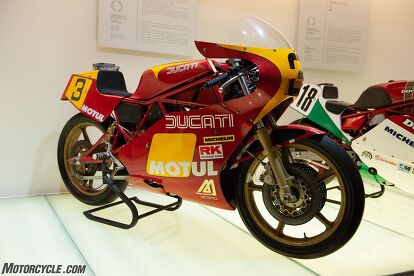














































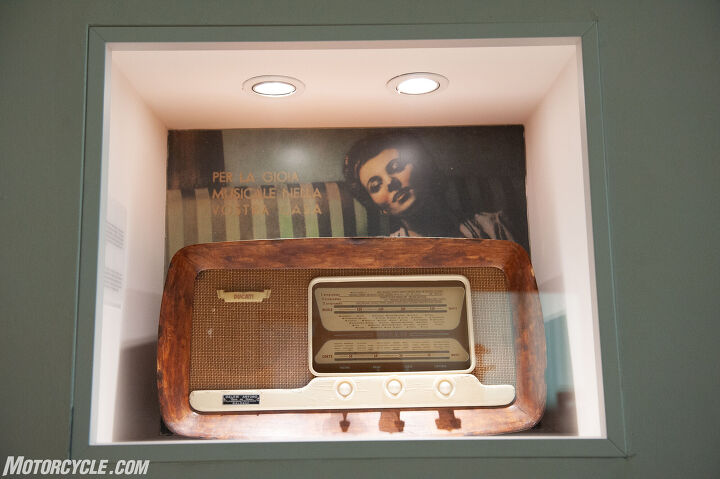



























































































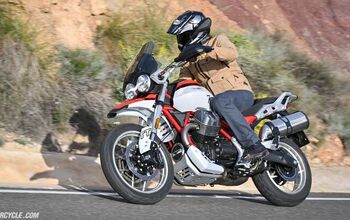

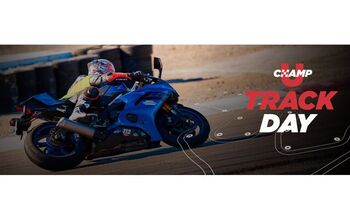









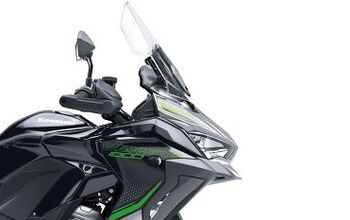

Comments
Join the conversation
His name is Livo Lodi, not Livo Loi.......
In 2005 I visited Ducati as a Moto Journalist and Livio personally showed me around the museum and the factory. We had lunch at the factory canteen. I ha per-requested that I would like to ride the Super Mono, but soon came to know the rarity of the bike. I also met Dominaceli for a while in his cabin. I rode the latest 999 for the weekend. The whole trip has a special place in my 'motorcycle journey'.
A decade later I got a Ducati Monster 795 and lived with it for 7 years and 40,000km.